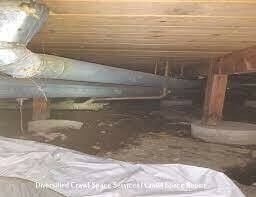
Introduction
Unpleasant odors in your crawl space can be a major problem. Not only do they make your home smell bad, but they can also indicate the presence of mold, mildew, pests, or other issues. It’s important to address these odors promptly to maintain a healthy and comfortable living environment. In this article, we will explore various methods and techniques for getting rid of unpleasant odors in your crawl space.
The Importance of Crawl Space Cleanup
Crawl space cleanup is essential for maintaining a clean and healthy living environment. When left unchecked, crawl spaces can become breeding grounds for mold, mildew, pests, and other undesirable elements. Regular cleaning and maintenance can help prevent these issues and keep your crawl space odor-free.
Benefits of Crawl Space Cleanup
- Eliminates mold and mildew growth
- Prevents pest infestations
- Improves indoor air quality
- Reduces the risk of structural damage
- Enhances energy efficiency

Crawl Space Remediation
In some cases, crawl space cleanup may not be enough to completely eliminate unpleasant odors. This is where crawl space remediation comes into play. Remediation involves more extensive and specialized cleaning techniques to address underlying issues and ensure long-term odor control.
Common Techniques Used in Crawl Space Remediation
- Mold and mildew removal: Professional remediation experts can identify and safely remove any mold or mildew growth in your crawl space.
- Pest control: If pests are present in your crawl space, remediation specialists can safely eradicate them and prevent future infestations.
- Insulation installation: Proper insulation can help regulate temperature and moisture levels in your crawl space, reducing the risk of odors and other issues.
- Vapor barrier installation: A vapor barrier can prevent moisture from seeping into your crawl space, reducing the likelihood of mold and mildew growth.
Crawlspace Insulation
Insulation plays a crucial role in maintaining a comfortable and energy-efficient home. In the crawl space, insulation helps regulate temperature and moisture levels, preventing odors and other problems from arising. Properly insulating your crawl space can make a significant difference in odor control and overall indoor air quality.
Types of Insulation for Crawl Spaces
There are several types of insulation commonly used in crawl spaces:
1. Fiberglass Insulation
Fiberglass insulation is a popular choice due to its affordability and ease of installation. It is effective in reducing heat transfer and provides some soundproofing benefits. However, fiberglass insulation can be susceptible to moisture damage, so proper vapor barrier installation is crucial.

2. Spray Foam Insulation
Spray foam insulation is highly effective at sealing and insulating crawl spaces. It expands to fill even the tiniest gaps and creates an airtight barrier, preventing moisture and air infiltration. However, professional installation is recommended for optimal results.
3. Rigid Foam Insulation
Rigid foam insulation boards offer excellent thermal resistance and moisture resistance. They are durable and can withstand harsh conditions. Rigid foam insulation should be properly sealed and installed to prevent air and moisture leaks.
FAQs
How much does crawl space cleanup cost?
How long does crawl space remediation take?
In conclusion, addressing unpleasant odors in your crawl space requires thorough cleanup, remediation, and insulation. Professional assistance may be necessary for more complex cases. Regular maintenance and vigilance can help prevent odors and maintain a clean and healthy crawl space.
If you need professional assistance with crawl space cleanup, remediation, or insulation, contact Service Water Restoration Pros at 949-209-1582.


